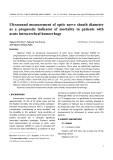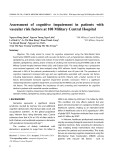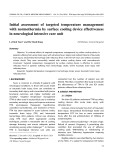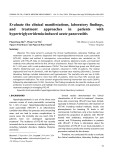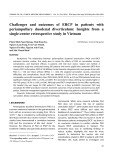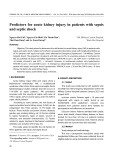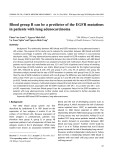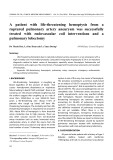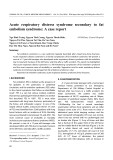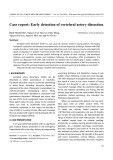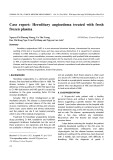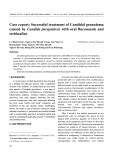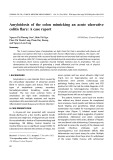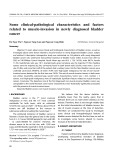Tissue expression and biochemical characterization of human 2-amino 3-carboxymuconate 6-semialdehyde decarboxylase, a key enzyme in tryptophan catabolism Lisa Pucci*, Silvia Perozzi*, Flavio Cimadamore, Giuseppe Orsomando and Nadia Raffaelli
Istituto di Biotecnologie Biochimiche, Universita` Politecnica delle Marche, Ancona, Italy
Keywords ACMSD; NAD biosynthesis; picolinate; quinolinate; tryptophan catabolism
for
Correspondence N. Raffaelli, Istituto di Biotecnologie Biochimiche, Universita` Politecnica delle Marche, Via Ranieri, 60131 Ancona, Italy Fax: +39 712204677 Tel: +39 712204682 E-mail: n.raffaelli@univpm.it
*These authors contributed equally to this paper
(Received 16 November 2006, accepted 6 December 2006)
doi:10.1111/j.1742-4658.2007.05635.x
2-Amino 3-carboxymuconate 6-semialdehyde decarboxylase (ACMSD, EC 4.1.1.45) plays a key role in tryptophan catabolism. By diverting 2-amino 3-carboxymuconate semialdehyde from quinolinate production, the enzyme regulates NAD biosynthesis from the amino acid, directly affecting quinoli- nate and picolinate formation. ACMSD is therefore an attractive therapeu- tic target treating disorders associated with increased levels of tryptophan metabolites. Through an isoform-specific real-time PCR assay, the constitutive expression of two alternatively spliced ACMSD transcripts (ACMSD I and II) has been examined in human brain, liver and kidney. Both transcripts are present in kidney and liver, with highest expression occurring in kidney. In brain, no ACMSD II expression is detected, and ACMSD I is present at very low levels. Cloning of the two cDNAs in yeast expression vectors and production of the recombinant proteins, revealed that only ACMSD I is endowed with enzymatic activity. After purification to homogeneity, this enzyme was found to be a monomer, with a broad pH optimum ranging from 6.5 to 8.0, a Km of 6.5 lm, and a kcat of 1.0 s)1. ACMSD I is inhibited by quinolinic acid, picolinic acid and kynurenic acid, and it is activated slightly by Fe2+ and Co2+. Site-directed mutagen- esis experiments confirmed the catalytic role of residues, conserved in all ACMSDs so far characterized, which in the bacterial enzyme participate directly in the metallocofactor binding. Even so, the properties of the human enzyme differ significantly from those reported for the bacterial counterpart, suggesting that the metallocofactor is buried deep within the protein and not as accessible as it is in bacterial ACMSD.
tryptophan
channeling
acid cycle via the glutarate pathway, or converted nonenzymatically to picolinate. By catalyzing ACMS decarboxylation, ACMSD thus diverts ACMS from NAD synthesis, towards complete oxidation or conversion to picolinate.
(AMS) by
In mammals, tryptophan exceeding basal requirement for protein and serotonin synthesis, is oxidized via indole-ring cleavage through the kynurenine pathway, consisting of several enzymatic reactions leading to 2-amino 3-carboxymuconate 6-semialdehyde (ACMS) [1,2]. ACMS can be decarboxylated to (Fig. 1) 2-aminomuconate the 6-semialdehyde enzyme ACMS decarboxylase (ACMSD, EC 4.1.1.45), or it can undergo spontaneous pyridine ring closure to form quinolinate, an essential precursor for de novo NAD synthesis. AMS can be routed to the citric
By determining picolinate and quinolinate forma- tion, ACMSD directly participates in the cellular pro- cesses regulated by these molecules. Quinolinate is a neurotoxic tryptophan metabolite, whose action has been ascribed to N-methyl-D-aspartate receptors activation and to its ability to generate free radicals
Abbreviations ACMS, 2-amino 3-carboxymuconate 6-semialdehyde; ACMSD, ACMS decarboxylase; AMS, 2-aminomuconate 6-semialdehyde.
FEBS Journal 274 (2007) 827–840 ª 2007 The Authors Journal compilation ª 2007 FEBS
827
L. Pucci et al.
Human ACMSD
Fig. 1. Schematic overview of tryptophan catabolism through the kynurenine pathway.
In particular, many of
exhibits
[3,4]. This neurotoxicity might play an important role in the pathogenesis of major neurodegenerative and convulsive disorders. the distinct neuropathological features of Huntington’s disease are duplicated in experimental animals by intrastriatal quinolinate injection [5,6]. In addition, a significant elevation of quinolinate levels has been observed in low-grade Huntington’s disease brains, suggesting that the molecule might participate in the initial phases of the neurodegenerative process [7]. Moreover, a role of quinolinate in the pathogenesis of AIDS–dementia complex, as well as Alzheimer’s disease, has been very recently proposed [8,9]. In turn, picolinate immunomodulatory important properties, involving activation of macrophage tumori-
cidal, microbicidal and proinflammatory functions [10– 12]. This metabolite also stimulates apoptosis in var- ious transformed cell lines, and efficiently interrupts the progress of human HIV-1 in vitro [13,14]. Although the physiological relevance of picolinate formation in vivo is not known, it has been detected in human milk, pancreatic juice, intestine and in the serum of patients with degenerative liver diseases [15–17]. In addition, high levels have been measured in the cerebrospinal fluid of children with cerebral malaria and in the brain of a murine model of the syndrome [18,19]. Interestingly, picolinate is reportedly able to prevent the neurotoxic effects of quinolinate in the rat central nervous system, suggesting that a highly regula- ted production of these metabolites is required for
FEBS Journal 274 (2007) 827–840 ª 2007 The Authors Journal compilation ª 2007 FEBS
828
L. Pucci et al.
Human ACMSD
function [20]. Such considerations normal neuronal indicate that ACMS decarboxylation is a key meta- bolic control step and that the enzyme catalyzing this reaction is likely to be a drug target [21].
[22–24], where it
in GenBank under
RNA, by using the primers pair 1fw ⁄ 11rev, encompas- sing the ACMSD open reading frame (GenBank acces- sion number Q8TDX5-1) (Fig. 2A; Table 1). Agarose gel electrophoresis of the PCR product indicated the two distinct bands between 1000 and presence of 1100 bp of roughly the same extent (not shown). Clo- ning and nucleotide sequencing of these two products indicated that the lower band (1011 bp) corresponded to the expected cDNA (here named ACMSD I), while the higher band (1068 bp) corresponded to the cDNA currently accession number AAH16018 (here named ACMSD II). ACMSD II cod- ing sequence was obtained by using the primers pair 4fw ⁄ 11 rev (Fig. 2A). Again, two distinct PCR prod- ucts were obtained, the longer (887 bp) corresponding to part of the ACMSD I cDNA, the shorter (837 bp) representing ACMSD II open reading frame (not shown). The two transcripts are produced by alternat- ive splicing of exons 2 and 5 of the ACMSD gene (Fig. 2A); the presence of exon 2 in ACMSD II causes a shift in the open reading frame, resulting in the occurrence of the first available start codon in exon 4. This, together with the absence of exon 5, gives rise to a ACMSD II protein, which differs from ACMSD I at the N-terminus (Fig. 2B).
Mammalian ACMSD has been purified and charac- terized from cat, hog and rat is present only in kidney, brain and liver. Several studies have demonstrated that in rats, nutritional factors and hormones affect both gene expression and enzymatic activity. In particular, the enzyme is down-regulated by dietary polyunsaturated fatty acids, phthalate esters and peroxisome proliferators, like clofibrate, whereas it is up-regulated in rats fed a high protein diet [25–28]. mRNA expression and enzymatic activity are elevated in the liver of streptozotocin-induced diabetic rats, and insulin injection suppresses such elevation [29]. These studies clearly demonstrated that changes in ACMSD activity are readily reflected by serum and tissue quino- linate levels and in the rate of tryptophan-to-NAD conversion. Rat liver ACMSD gene expression is regu- lated by the two transcriptional factors: hepatocyte nuclear factor 4a (HNF4a) and peroxisome prolifera- tor-activated receptor a (PPRa); the former activates ACMSD expression directly by site-specific binding to the promoter, and the latter represses ACMSD expression indirectly through suppression of HNF4a expression [30].
Expression of ACMSD variants in Escherichia coli and Pichia pastoris
The presence of ACMSD has been recently demon- strated in bacteria species that fully catabolize trypto- phan or 2-nitrobenzoic acid [31,32]. The biochemical and structural characterization of Pseudomonas fluores- cens ACMSD revealed that the enzyme is metal- dependent and catalyzes a novel type of nonoxidative decarboxylation [21,33–35].
The human gene has been identified upon expression in COS7 cells of a cDNA from a brain library, enco- ding the human homologue of the rat protein [36]. Recently, a cDNA sequence from a liver library, deri- ving from alternative splicing of the gene, has been deposited in GenBank. In this study, we have demon- strated the constitutive expression in human organs of the two alternatively spliced ACMSD transcripts. The corresponding cDNAs have been cloned in yeast expression vectors, allowing for the first time the puri- fication and biochemical characterization of human ACMSD.
Results
crude
the
Cloning of ACMSD transcripts
The complete coding sequence of human ACMSD was obtained from reverse-transcribed human kidney
ACMSD I and II cDNAs were subcloned into pET15b and pET32b E. coli expression vectors, providing the recombinant proteins with a N-terminal His6-tag, and a thioredoxin-tag, respectively. In both cases, proteins were expressed as inclusion bodies (not shown). Any effort to obtain soluble recombinant proteins, inclu- ding lower growth temperatures (18 (cid:2)C) and isopropyl b-D-1-thiogalactopyranoside concentrations (down to 0.1 mm), as well as inclusion of various metal ions in the growth medium during induction, were unsuccess- ful. Expression in the methylotrophic yeast P. pastoris was performed both via secretion and intracellularly, as described in Experimental procedures. Both isoforms were secreted by yeast cells transformed with the pPIC9 recombinant plasmids (Fig. 3); however, when ACMSD activity was assayed in the culture media, the enzymatic activity was only detected in media containing isoform I. Both isoforms were also expressed intracellularly, as evidenced by the the expected size appearance of protein bands of upon SDS ⁄ PAGE analysis of extracts prepared after 3 days methanol induction (not shown). Again, only isoform I was endowed with enzymatic activity.
FEBS Journal 274 (2007) 827–840 ª 2007 The Authors Journal compilation ª 2007 FEBS
829
L. Pucci et al.
Human ACMSD
A
B
Fig. 2. Alternative splicing of human ACMSD gene. (A, upper panel) Genomic structure of the ACMSD gene with the alternative splicing pat- terns. Exons are indicated by boxes and introns by connecting lines. The approximate locations of the oligonucleotide primers used in the preparation of the cDNAs are shown by bold arrows (see Table 1 for sequences). (A, lower panel) Representation of full length ACMSD I and ACMSD II mRNAs. Open reading frames are underlined and the localization of the primers pairs and probes used for real-time PCR assays is also showed (see Table 1 for sequences). (B) Alignment of the not conserved N-terminal regions of the two isoforms. Alignment was carried out using the CLUSTALW program. Fully conserved and similar residues are indicated by asterisks and colon, respectively.
fw,
forward;
rev,
A
B
Table 1. Oligonucleotide primer sequences. reverse.
Sequence
ACMSD cloning: primer
1fw
11rev
4fw
CGCTCGAGATGAAAATTGACATCCATA GTCAT AAAGCTGAGCTCCATTCAAATTGTTTT CTCTCAAG TTCTCGAGATGGGAAAGTCTTCAGAGT GGT
ACMSD real-time PCR: primer and probe
TGGCCAGATCTAAAAAAGAGGT ATCCCAGGAAACACCAGTAGA ATTGTTTTCTCTCAAGACCCAA
Fig. 3. ACMSD I and ACMSD II extracellular expression. Tricine SDS ⁄ PAGE of the culture filtrates of the best expressing clones obtained by transformation of P. pastoris GS115 cells with pPIC9- ACMSD I (A) and pPIC9-ACMSD II (B). Culture filtrates were ana- lyzed after 104 h (lane a) and 128 h (lane b) methanol induction. Arrows indicate the recombinant isoforms. Lane M, molecular mass standards.
1 ⁄ 3fw 2fw 10rev TaqMan probe T1 ACACCACAGCAAGGGAGAAGCAAAG 18Sfw CGCCGCTAGAGGTGAAATTC 18Srev TCTTGGCAAATGCTTTCGCT TaqMan probe 18S TGGACCGGCGCAAGACGGAC
In light of the recent findings that P. fluorescens ACMSD requires a metal-ion cofactor and is able to take up the metal from the expressing host during protein synthesis [21,33], we investigated whether the
production of the human recombinant isoforms might be enhanced by the presence of metal ions in the growth medium. We found that addition of 200 lm to 1 mm CoCl2 during methanol induction did not result in a significant increase of ACMSD I specific activity, and no activity was detected in the extracts prepared from cells expressing the other isoform.
FEBS Journal 274 (2007) 827–840 ª 2007 The Authors Journal compilation ª 2007 FEBS
830
L. Pucci et al.
Human ACMSD
10 000-fold molar excess of ACMSD II and the same result was obtained when detection of ACMSD II was performed in the presence of ACMSD I. The expression levels of ACMSD alternative transcripts in the organs we have examined are reported in Fig. 4. ACMSD I transcript was present in all tested organs, with an expression ratio of 1300 : 30 : 1 in kidney, liver and brain, respectively. Interestingly, ACMSD II was not detected in brain, while no significant difference in the relative expression of the two isoforms within kidney and liver was observed.
ACMSD I purification and characterization
Fig. 4. Quantitation of ACMSD variants by real-time PCR. Tissues RNA was reverse-transcribed and ACMSD variants were quantita- ted as described in Experimental procedures, using the prim- ers ⁄ probe sets reported in Table 1. Data are the mean of three independent experiments and are presented as copies of the target variant per 109 copies of 18S RNA.
Quantitation of ACMSD variants in liver, kidney and brain
Recombinant human ACMSD I was purified to homo- geneity from P. pastoris cells transformed with the pHIL-D2-ACMSD I plasmid, by the purification proce- dure described in Experimental procedures and sum- marized in Table 2. The final preparation was stable for several weeks when stored at 4 (cid:2)C, whereas the purified protein was sensitive to freezing at both )20 (cid:2)C and )80 (cid:2)C. SDS ⁄ PAGE of the pure protein revealed a molecular mass of about 40 kDa, as expected for the recombinant enzyme (Fig. 5). Gel filtration experiments showed a native molecular mass of about 50 kDa, indi- cating that the enzyme might exist as a monomer in solution (not shown). ACMSD I had an optimum pH ranging from 6.5 to 8.0 (Fig. 6). The activity was signifi- cantly affected by the concentrations of the buffers used at pH values below 6.5, being markedly lower in the presence of 50 mm buffers, rather than 5 mm at the same pH values (Fig. 6). As shown in Table 3, the pure enzyme was fully active in the absence of metal ions, being slightly activated by Co2+ and Fe2+, whereas Zn2+, Cd2+ Cr3+ and Fe3+ strongly reduced the enzy- matic activity. Human ACMSD I exhibited a linear kin- etic behavior, with Km for ACMS of 6.5 lm, Vmax of 0.105 mm s)1 and kcat of 1.0 s)1 (Fig. 7).
An isoform-specific real-time PCR assay was performed to analyze the expression pattern of the two transcripts in brain, kidney and liver. A hybridization probe over- lapping exon 3 and exon 4 was designed (T1), which is able to anneal to both variants (Fig. 2A). Specific ampli- fication was achieved by using the same reverse primer (10rev), located in exon 10, with 1 ⁄ 3fw primer, spanning the boundaries of exons 1 and 3, for ACMSD I, and 2fw, located in exon 2, for ACMSD II. To assess the specificity of the assay, linearized pGEM plasmids har- boring the two cDNAs were used as templates in control real-time PCR experiments. Each isoform was subjected to amplification with the specific primer ⁄ probe set in the presence of increasing molar amounts of the other iso- form (1 : 1, 1 : 1000 and 1 : 10 000). Detection of ACMSD I was not influenced by the presence of up to
To identify possible enzyme modulators, we exam- ined the effect of several NAD biosynthetic pathway intermediates on the human enzyme activity. We found that NAD, nicotinate adenine dinucleotide, nicotina-
Table 2. Purification of recombinant human ACMSD I.
Step
Total proteina (mg)
Total activityb (units)
Yield (%)
Purification (-fold)
Specific activity (unitsÆmg)1)
305 102
23.4
– 3.26 8.5
Crude extract Streptomycin sulfate Hydroxyhapatite MonoQ
0.36
1.9 2.0 1.2 0.5
0.006 0.019 0.051 1.39
100 100 63 31
231
aStarting from 400 mL yeast culture. bThe enzymatic activity was assayed spectrophotometrically, as reported in the Experimental proce- dures.
FEBS Journal 274 (2007) 827–840 ª 2007 The Authors Journal compilation ª 2007 FEBS
831
L. Pucci et al.
Human ACMSD
Table 3. Influence of metal ions on human ACMSD I activity.
Metal ion
Concentration (mM)
Relative activity (%)
None Mg2+ Mn2+ Zn2+ Ni2+ Ca2+ Fe3+ Fe2+
Co2+
Cr3+ Cd2+
– 1.0 1.0 0.1 1.0 1.0 0.1 0.1 1.0 0.1 1.0 0.5 0.5
100 100 100 6 100 100 15 124 90 120 130 35 25
fractions throughout
recombinant human ACMSD I. Tricine Fig. 5. Purification of SDS ⁄ PAGE of the purification procedure: crude extract (lane a), hydroxyhapatite (lane b), MonoQ (lane c). Lane M, molecular mass standards.
Fig. 7. Lineweaver)Burk analysis of ACMSD I. The reciprocal of the initial velocities was plotted against the reciprocal of ACMS concentrations. Data are the means of three independent determi- nations.
Fig. 6. Effect of pH on ACMSD I activity. The enzymatic activity was measured at different pH values in 50 mM (h) and 5 mM (j) sodium succinate, 50 mM (s) and 5 mM (d) Mes, 50 mM 4-morph- olinepropanesulfonic acid (m), 50 mM Hepes (r) and 50 mM (e) buffers. Activity was determined as described in Tris ⁄ HCl Experimental procedures.
Table 4. Influence of tryptophan catabolites on human ACMSD I activity.
Compound
Concentration (mM)
Relative activity (%)
Kynurenic acid
Quinolinic acid
Picolinic acid
mide, nicotinic acid, nicotinamide mononucleotide, nicotinate mononucleotide, tryptophan (present at 1 mm concentration in the reaction mixture), and l-kynurenine and 3-hydroxykynurenine (present at 0.1 mm concentration) were without effect. On the other hand, a significant inhibition was exerted by quinolinic acid, picolinic acid and kynurenic acid, as shown in Table 4.
0.5 1.0 0.5 1.0 0.25 0.5 1.0
67 59 72 61 80 58 47
directed mutagenesis experiments on human ACMSD I to replace His6 and His8 individually with alanine. Mutated proteins were expressed in P. pastoris cells at a level comparable with that of the wild-type enzyme
Bacterial and human ACMSD share a high sequence identity, particularly with respect to the residues (i.e. His9, His11, His177 and Asp294) known to be involved in metal binding in P. fluorescens ACMSD (Fig. 8). To confirm that these residues are essential for the human enzyme activity, we performed site-
FEBS Journal 274 (2007) 827–840 ª 2007 The Authors Journal compilation ª 2007 FEBS
832
L. Pucci et al.
Human ACMSD
Fig. 8. Alignment between human (Hs) and P. fluorescens (Psf) ACMSD. Residues involved in metal binding in the bacterial enzyme are highlighted in shaded boxes. Residues subjected to mutational analysis in the human enzyme are indicated by #.
In particular,
4 (cid:2)C [21,33], human ACMSD retained full activity in the same conditions. Incubations at EDTA concentra- tions higher than 10 mm (i.e. 20 mm and 50 mm) only resulted in 50% loss of the decarboxylase activity. Moreover, unlike the P. fluorescens ACMSD apopro- tein, which can be successfully reconstituted [21,33], catalytic activity of the human enzyme was not regained upon removal of EDTA and addition of metal-ions.
Figure 9 shows
(not shown) and, as expected, exhibited a significantly lower catalytic activity. the activity decreased by about 82% and 50% for His6Ala and His8Ala, respectively, indicating that the mutated resi- dues are critical for catalysis. The human enzyme is active in the absence of added metal-ions in the reac- tion mixture, suggesting that it might be able to take up the metal from the expressing host during protein synthesis. This property was previously demonstrated for bacterial ACMSD, however, while the bacterial enzyme can be obtained in the inactive, metal-free form upon incubation with 5 mm EDTA for 12 h at
the hydrophobicity profiles of human and P. fluorescens ACMSD, performed accord- ing to Kyte and Doolittle [37]. By comparing the mean
A
B
Fig. 9. Hydrophobicity profiles of human (A) and P. fluorescens (B) ACMSD. The profiles were computed according to Kyte and Doo- little [37], using a window size of 7, suitable for discriminating between buried and sur- face exposed regions. Residues involved in catalysis in the bacterial enzyme and the corresponding amino acids in the human protein are pointed with arrows. The mean hydrophobicity values of residues within the window centered on the pointed amino acids are reported in brackets.
FEBS Journal 274 (2007) 827–840 ª 2007 The Authors Journal compilation ª 2007 FEBS
833
L. Pucci et al.
Human ACMSD
hydrophobic index of the residues within the window centered on amino acids involved in metal binding, it can be noticed that regions around His6 and His8 in the human protein are predicted to be more hydropho- bic than the corresponding regions in the bacterial enzyme. Likewise Arg47, whose corresponding residue in P. fluorescens ACMSD (Arg51) is essential for cata- lysis and it has been hypothesized to directly partici- is located in a more pate in substrate binding [34], hydrophobic region in human ACMSD.
Pseudomonas fluorescens ACMSD crystallographic structures have been used as the templates for the pre- diction of the human enzyme structure based on homology modeling. As shown in Fig. 10, the overall architecture of the human enzyme model is very sim- ilar to that of its bacterial counterpart. In particular, the root-mean-squared deviations values calculated between the superimposed backbones of the human enzyme model and the crystallographic templates are all below 1 A˚ . The residues that directly coordinate to
A
B
C
Fig. 10. Homology modeling of human ACMSD I. Prediction of the human enzyme structure (right) was made on the base of the crystal structure analysis of P. fluorescens ACMSD (left), as described in Experimental procedures. (A) Ribbon diagram of the two structures. The arginine residue probably involved in substrate binding is marked by an asterisk, and the residues ligated to the metal ion cofactor (orange sphere) are shown in ball-and-stick representation (B) metal coordination centers. (C) Molecular surface models. Hydrophobic and polar resi- dues are colored in blue and gray, respectively.
FEBS Journal 274 (2007) 827–840 ª 2007 The Authors Journal compilation ª 2007 FEBS
834
L. Pucci et al.
Human ACMSD
the metal cofactor in the bacterial protein are con- served in the human model (Fig. 10B). The molecular surface model of both proteins, shown in Fig. 10C, confirm the higher hydrophobicity in human ACMSD of the region surrounding the metal active site and the Arg47 likely involved in substrate binding.
characterized,
Discussion
a
broad
ranging
pH optimum,
failure,
ACMSDs, due to the rapid inactivation of the human enzyme both in the absence of salts and in the presence of high ionic strength (i.e. NaCl or sulfate ammonium concentrations higher than 0.3 and 0.4 m, respectively). The subunit and native molecular weight values are comparable with those reported for all ACMSDs so far including the bacterial protein [23,24,34], and are consistent with the lack of a quater- nary structure. In contrast with the rat enzyme, which is mostly active at pH 6.0 [24], human ACMSD displays from pH 6.5–8.0. Like all ACMSDs [22–24,34], the human enzyme exhibits a very low micromolar-range Km for ACMS. However, it shows a specific activity six times lower than that reported for the rat enzyme and a kcat value that is about 6.5 times lower than that calculated for the bacterial counterpart [24,34]. The enzymatic activity is not significantly affected by the intermedi- ates of the NAD biosynthetic pathways. Given that the high concentrations required for inhibition by quinolinic acid, picolinic acid and kynurenic acid are far from the physiopathological levels of the trypto- phan metabolites [8], these effects are unlikely to be of physiological significance. However, it may be worth noting that the three inhibitory compounds share a COOH group on the C-2 of the pyridine ring. This feature seems to be essential for ACMSD inhibition, since nicotinic acid, which differs from picolinic acid only in the position of the COOH group, was ineffective.
Very recently,
residues
In this study, the expression of the human ACMSD transcript coding for the active enzyme has been exam- ined in kidney, liver and brain. The tissue distribution the transcript closely resembles that of mouse of ACMSD mRNA [36]. The highest expression has been observed in kidney, suggesting that the tryptophan- NAD pathway might not be the preferred route of tryptophan utilization in this organ. Indeed, in kidney the kynurenine pathway is mostly used to convert and tryptophan catabolites, including kynurenine hydroxykinurenine taken up from the blood, to a series of metabolites which are then excreted [38]. The presence of ACMSD suggests that tryptophan catabo- lites might also be channeled into the glutarate path- way towards complete oxidation. High levels of the enzyme might prevent excessive formation and accu- mulation of quinolinate. Indeed experiments performed on patients with renal insufficiency, as well as on rats with induced renal showed a decrease of kidney ACMSD activity and significant elevation of quinolinate in serum, urine, cerebrospinal fluid and peripheral tissues [38–41]. On the other hand, we found significantly lower levels of human ACMSD expression in liver and in brain than that observed in kidney, suggesting that in the former organs the tryp- tophan–NAD conversion might represent a relevant pathway. Indeed, most of the intracellular NAD in liver is synthesized from the amino acid rather than from dietary niacin and the formed dinucleotide is the main vitamin source for extrahepatic tissues [42]. Like- wise, maintenance of brain NAD levels is of extreme importance, because NAD depletion is linked to neur- onal damage. Recent reports have demonstrated that reversal of NAD depletion can profoundly decrease is- chemic brain damage and stimulation of NAD biosyn- thetic pathways prevents or delays axonal degeneration [43,44]. The observed low levels of liver and brain ACMSD would allow tryptophan to be channeled towards NAD formation, thus guaranteeing adequate NAD supply.
the active
the structural characterization of P. fluorescens ACMSD has demonstrated that the bacterial enzyme requires a transition metal ion as co- factor (i.e. Zn2+), thus representing a novel member of the metal-dependent amidohydrolase superfamily [21,34]. Members of this superfamily employ a great variety of divalent metal ligands for catalysis and share a conserved metal binding site, suggesting com- mon aspects in their catalytic mechanism [21]. From the sequence alignment of human and bacterial AC- MSD and the comparison of their three-dimensional structures, the presence of the metallocofactor in the in human enzyme can be reliably predicted. Indeed, the essentiality in the human the present work, enzyme-catalyzed reaction of involved in metal binding in P. fluorescens ACMSD has been confirmed by site-directed mutagenesis. As expected, replacement of His6 and His8 with alanine in human ACMSD I resulted in a significant reduction of the decarboxylase activity. Accordingly, ACMSD II iso- form, which differs from ACMSD I in the first 24 residues at the N-terminus and lacks the two mutated to histidines,
is enzymatically inactive. In contrast
Our work defines a reliable procedure for the expres- recombinant sion and purification of ACMSD in good yield. The purification method reported for other mammalian differs
from that
FEBS Journal 274 (2007) 827–840 ª 2007 The Authors Journal compilation ª 2007 FEBS
835
L. Pucci et al.
Human ACMSD
the
protein
restored
bacterial
tion of the residues which in ACMSD I mark the boundary of the predicted substrate-binding pocket, reveals that some of them are conserved in the inac- tive isoform (i.e. Trp191 and Phe294). Even though the precise role of these active site residues has not been established, the possibility that ACMSD II might still be able to bind the substrate cannot be definitively ruled out. If this would be the case, the metabolic relevance of the inactive isoform would be related to its capability of binding and sequestering a reactive intermediate like ACMS.
The results we have presented represent the first bio- chemical report on human ACMSD. They may be in promoting the structural analysis of instrumental the protein, particularly with respect to developing therapeutic leads for treating disorders associated with increased levels of quinolinate and ⁄ or picolinate.
Experimental procedures
PCR amplification and cloning of ACMSD isoforms
what observed for the bacterial enzyme, however, human recombinant ACMSD specific activity was not increased by the presence of divalent metal ions in the growth medium, during protein expression. In than those addition, EDTA concentrations higher used for the preparation of the bacterial apoprotein were required to obtain a significant inactivation of the human enzyme, and we were not able to recon- stitute the activity by using the treatment that suc- cessfully [21,33]. Interestingly, the same difficulty in stripping off the metallocofactor from the protein has been described for murine adenosine deaminase, a member of the amidohydrolase superfamily, which uses Zn2+ as co- factor and shares with ACMSD the same metal cen- ter configuration [34,45]. The metal was inaccessible to chelators, and was not exchanged with solvent to any appreciable extent at neutral pH [45]. Authors also reported a competitive inhibition by Zn2+ with respect to the substrate (Ki 7 lm), suggesting that the cation might bind elsewhere within the enzyme active site and block adenosine binding [45]. Accordingly, we found that 0.1 mm Zn2+ exerts a strong inhibitory effect on human ACMSD. The presence of the metal- locofactor in human ACMSD might also be inferred by our study on the enzyme pH dependence, showing that the increase of the concentrations of succinate and 4-morpholineethanesulfonic acid buffers at pH values below 6.5 significantly reduced the activity. It can be hypothesized that these salts might chelate the metal and efficiently remove it from the protein at acidic pH.
structures
Human brain, liver and kidney total RNA (Clontech Laboratories, Inc., Mountain View, CA, USA) was reverse transcribed in the presence of random primers, by using the First Strand cDNA Synthesis kit (Biotech. Department Bio Basic Inc., Markham, Ontario, Canada). Transcripts enco- ding for the two splice variants were amplified by polym- erase chain reaction (PCR) using specific primers, and kidney cDNA as the template. PCR conditions were as fol- lows: 1 min at 94 (cid:2)C; 30 s at 94 (cid:2)C, 30 s at 55 (cid:2)C, 1 min at 72 (cid:2)C for 30 cycles; 10 min at 72 (cid:2)C. The reaction was per- formed in the presence of 0.5 pmolÆlL)1 of each primer, 200 lm dNTPs, 1 mm MgCl2 and 0.025 unitsÆlL)1 Taq polymerase (Finnzymes, Espoo, Finland). The amplified PCR products were separated on a 2% agarose gel, bands were excised and purified by using the High Pure PCR (Roche, Basel, Switzerland). Product Purification kit Purified DNA was subcloned into pGEM T easy vector (Promega, Madison, WI, USA) following manufacturer’s instructions and recombinant plasmids were sequenced.
Both the different sensitivity to EDTA, and the lower kcat value exhibited by the human protein with respect to the bacterial counterpart suggest that the active site is very well buried within the human pro- tein, not so easily accessible as it is in the bacterial enzyme. This conclusion is validated by the compar- ison of both the hydrophobicity profiles and the three- dimensional of human and bacterial ACMSD, demonstrating that the region surrounding residues involved in catalysis is more hydrophobic in the human, rather than in the bacterial protein.
Real-time PCR
Real-time PCR was performed on a Corbett (Sidney, Aus- tralia) Rotor Gene RG 3000. TaqMan probe and primers were designed using the primer3 program. Optimized amplification reactions contained 300 nm each primer, 400 nm probe, 5 mm MgCl2, 200 lm dNTPs, 1.25 Units JumpStart Taq DNA polymerase (Sigma-Aldrich Corp., St Louis, MO, USA) and 1 · of the provided buffer. All PCR reactions were performed with one cycle of 94 (cid:2)C for 60 s, followed by 45 cycles of 15 s at 94 (cid:2)C and 60 s at 60 (cid:2)C.
Finally, this study demonstrated the expression in kidney and liver of an alternatively spliced ACMSD transcript coding for a protein which differs from the other variant in the N-terminal region and carries an incomplete metal binding domain. In particular, in this variant only two out of four residues which are directly involved in the metal cofactor binding are present. Consistent with this structural deficiency is our finding that ACMSD II is catalytically inactive when overexpressed as recombinant protein. Inspec-
FEBS Journal 274 (2007) 827–840 ª 2007 The Authors Journal compilation ª 2007 FEBS
836
L. Pucci et al.
Human ACMSD
the cultures,
The time course of ACMSD expression in His+MutS cells was monitored in the cells crude extracts, prepared by sus- pending cells collected from 1 mL of in 100 lL of 50 mm sodium phosphate, pH 7.4, 5% glycerol, 1 mm phenylmethanesulfonyl fluoride, and disrupting them by vortexing with glass beads (0.5 mm) eight times for 30 s with 30-s intervals.
Site-directed mutagenesis
the PCR method using different pri- The efficiency of mer ⁄ probe sets was determined from the threshold cycle values obtained with 10-fold serial dilutions of linearized pGEM T easy vectors harboring the ACMSD variants. Standard curves for 18S RNA were obtained using cDNAs from each organ. All the calibration curves exhibited slopes ranging from 3.34 to 3.48, indicating comparable amplifica- tion efficiency. The copy number of each variant in the unknown samples was determined from the calibration curves and data were normalized to the copy number of 18S RNA.
Expression of ACMSD isoforms in E. coli
Mutagenesis to change the selected residues to Ala was carried out using the QuickChange kit (Stratagene, La Jolla, CA, USA). Mutagenic primers were: 5¢-CGCTCGAGA TGAAAATTGACATCGCTAGTCATATTCTACC-3¢ and its complement for His6Ala; 5¢-GACATCCATAGTGCT ATTCTACCAAAAGAATGGCC-3¢ and its complement for His8Ala (substituted nucleotides are underlined). pHIL- D2-ACMSD I was used as the template for the PCR mutagenesis reaction. Mutants were sequenced to verify incorporation of the desired modification and to ensure the absence of random mutations. The mutagenized plasmids were transformed into P. pastoris GS115 competent cells and expression was performed as for the wild-type protein. Crude extracts were analyzed by SDS ⁄ PAGE and assayed for the enzymatic activity.
ACMSD I purification
cells pGEM-ACMSD I and pGEM-ACMSD II were digested with XhoI and Bpu1102I and cloned into pET-15b and pET-32b expression vectors. The four constructs obtained were used to transform E. coli BL21(DE3) cells for proteins production. E. coli cells harboring the recombinant plas- mids were grown at 37 (cid:2)C in Luria–Bertani medium, containing 100 lgÆmL)1 ampicillin. After reaching an A600 of 0.3, cultures were shifted at 25 (cid:2)C and expression was induced with 1 mm isopropyl b-D-1-thiogalactopyranoside at an A600 of 0.6. Cells deriving from 1 mL cultures were collected at different induction times and the pellets were 20 mm Tris ⁄ HCl buffer, resuspended in 100 lL of pH 8.0, 1 mm MgCl2, 1 mm dithiothreitol, 1 mm phenyl- methanesulfonyl fluoride. Cells were disrupted by vortexing with glass beads (250 lm) four times for 1 min, with 2 min intervals. After centrifugation, the supernatants represent- ing the soluble fractions and the corresponding pellets were analyzed by SDS ⁄ PAGE [46].
Expression of ACMSD isoforms in P. pastoris
inserts correct constructs, orientation
FEBS Journal 274 (2007) 827–840 ª 2007 The Authors Journal compilation ª 2007 FEBS
837
All steps were performed at 4 (cid:2)C. 1 mm dithiothreitol and 5 mm 2-mercaptoethanol were included in all buffers. P. pastoris GS115 transformed with pHIL-D2- ACMSD I were incubated in buffered glycerol complex medium, at 30 (cid:2)C, up to an A600 of 3.0. The culture was centrifuged at 5000 g for 10 min (Sorvall centrifuge RC5B plus, Superlite GSA rotor) and the cell pellet was resus- pended in one-fifth of the original culture volume of buf- fered methanol complex medium. Cells were cultured for 5 days, at 30 (cid:2)C, with daily addition of methanol to main- tain a 0.5% concentration. Cells were harvested by centrifu- gation as above, and resuspended in 10 mL of lysis buffer containing 10 mm potassium phosphate, pH 7.0, 1 mm phe- nylmethanesulfonyl fluoride, and 0.02 mgÆmL)1 each of leupeptin, antipain, chymostatin, and pepstatin. After dis- ruption by three cycles of French Press (SLM-Aminco, Urbana, IL, USA) at 1000 p.s.i., the suspension was centri- fuged at 40 000 g for 20 min (Sorvall centrifuge RC5B plus, Kontron-Hermle A8.24 rotor). The supernatant was made 10 mgÆmL)1 by dilution with the lysis buffer, and strepto- mycin sulfate was added dropwise at a final concentration of 1%. After 20 min stirring, the sample was centrifuged at 8000 g for 10 min (Sorvall centrifuge RC5B plus, Kontron- Hermle A8.24 rotor) and the supernatant was loaded onto a hydroxyhapatite (Bio-Rad, Hercules, CA, USA) column equilibrated with 10 mm potassium (2.5 cm · 4.9 cm2) phosphate, pH 7.0, 50 mm NaCl. After washing with the pHIL-D2 and pPIC9 vectors (Invitrogen, San Diego, CA, USA) were used for intracellular and extracellular expres- sion, respectively; pGEM plasmids harboring ACMSD I, II were digested with EcoRI and the purified products were ligated into the expression vectors at the EcoRI site. In the resulting and sequence were checked by automated sequencing. Transfor- mation of P. pastoris GS115 competent cells with SalI line- arized recombinant pPIC9 plasmids generated clones with a His+Mut+ phenotype. Transformation of the same yeast cells with NotI linarized recombinant pHIL-D2 plasmids favored the alcohol oxidase structural gene displacement, allowing generation of His+MutS phenotype [47]. PCR-pos- itive His+Mut+ and His+MutS clones were cultured in buffered glycerol-complex medium, and for expression induction, cultures were transferred in buffered methanol- complex medium and grown with daily methanol pulses, as described in [47]. At different induction times, aliquots of the culture filtrate of His+Mut+ cells were subjected to SDS ⁄ PAGE analysis and ACMSD activity determination.
L. Pucci et al.
Human ACMSD
same buffer, the recombinant protein was eluted with a lin- ear gradient of potassium phosphate from 10 mm to 0.3 m, containing 50 mm NaCl. The active pool was dialyzed against 10 mm Tris ⁄ HCl, pH 8.0, 25 mm NaCl, and applied to a fast protein liquid chromatography column of MonoQ (Pharmacia, Stockholm, Sweden), equilibrated with the dialysis buffer. After washing with the same buffer, elution was performed with 10 mm Tris ⁄ HCl, pH 8.0, 0.13 m NaCl. Active fractions were pooled and stored at 4 (cid:2)C.
Gel filtration chromatography
2HBX, respectively) using the SWISS-PDBviewer software in conjunction with the SWISS-MODEL server (http:// www.expasy.org/spdbv/). The quality of the predicted struc- ture was checked by computing its Ramachandran plot using procheck program [48]: 86.6% of the residues were in the most favored regions, 12.1% in the additional allowed, three residues in the generously allowed (Asn148, Leu246 and Glu298) and only two residues in the forbidden regions (Asp181 and Met180). The human ACMSD–Zn2+ complex was constructed by superimposing the ACMSD model with the bacterial ACMSD–Zn2+ complex and past- ing the zinc ion in the predicted human structure. Figures were generated with the software swiss-pdbviewer and visual molecular dynamics [49].
Acknowledgements
ACMSD I native molecular weight was determined by gel- filtration on a Superose 12 HR 10 ⁄ 30 column (Amersham, Piscataway, NJ, USA). For elution, a buffer containing 10 mm Tris ⁄ HCl, pH 8.0, 0.2 m NaCl, 1 mm dithiothreitol and 5 mm 2-mercaptoethanol was used. Standard proteins were b-amylase (200 kDa), bovine serum albumin (66 kDa), ovalbumin (45 kDa) and carbonic anhydrase (30 kDa).
We thank G. Magni and S. Ruggieri for helpful com- ments and suggestions and T. Begley (Department of Chemistry and Chemical Biology, Cornell University, New York, NY) for the gift of the plasmid pKLC100.
Assay for ACMSD activity
References
1 Bender DA (1983) Biochemistry of tryptophan in health and disease. Mol Aspects Med 6, 101–197. 2 Magni G, Amici A, Emanuelli M, Orsomando G,
enzyme recombinant Raffaelli N & Ruggieri S (2004) Enzymology of NAD homeostasis in man. Cell Mol Life Sci 61, 19–34. 3 Stone TW (2001) Endogenous neurotoxins from trypto- phan. Toxicon 39, 61–73.
4 Rios C & Santamaria A (1991) Quinolinic acid is a potent lipid peroxidant in rat brain homogenates. Neurochem Res 16, 1139–1143.
pH 6.0, was incubated acid, at
5 Schwarcz R, Whetsell WO & Mangano RM (1983) Quinolinic acid: an endogenous metabolite that produces axon-sparing lesions in rat brain. Science 219, 316–318.
6 Burns LH, Pakzaban P, Deacon TW, Brownell AL, Tatter SB, Jenkins BG & Isacson O (1995) Selective putaminal excitotoxic lesions in non-human primates model the movement disorder of Huntington’s disease. Neuroscience 64, 1007–1017.
7 Guidetti P, Luthi-Carter RE, Augood SJ & Schwarcz R (2004) Neostriatal and cortical quinolinate levels are increased in early grade Huntington’s disease. Neurobiol Dis 17, 455–461. ACMSD activity was determined spectrophotometrically, by measuring ACMS consumption, as described in [23]. In our assay mixture, human 3-hydroxyanthranilic acid dioxygenase, which is used to catalyze ACMS formation from hydroxyanthranilic acid, was replaced with a dia- lyzed crude extract of E. coli BL21 (DE3) cells expressing from Ralstonia metallidurans. the (Plasmid pKLC100 harboring R. metallidurans 3-hydroxy- anthranilic acid dioxygenase was kindly provided by T. Begley, Cornell University, New York, NY). Briefly, a pre-assay mixture consisting of 25 lm hydroxyanthranilic acid and 0.01 units of R. metallidurans 3-hydroxyanthrani- in 50 mm 4-morpholinepropanesulf- lic acid dioxygenase, onic 25 (cid:2)C, with monitoring ACMS formation at 360 nm. After the reac- tion was complete, an appropriate aliquot of ACMSD was added and the activity was calculated by the the decrease in absorbance. Data were corrected for spontaneous decrease in absorbance due to the cycliza- tion of ACMS to quinolinate. The effect of ACMS concentration on the enzyme activity was investigated by varying 3-hydroxyanthranilic acid concentration from 2 to 20 lm. Kinetic parameters were calculated from the initial velocity data by using the Lineweaver-Burk plot. One unit is defined as the amount of ACMSD consu- ming 1 lmol ACMS per minute at 25 (cid:2)C. 8 Guillemin GJ, Wang L & Brew BJ (2005) Quinolinic
Three-dimensional structure prediction
acid selectively induces apoptosis of human astrocytes: potential role in AIDS dementia complex. J Neuroinflam 2, 16.
FEBS Journal 274 (2007) 827–840 ª 2007 The Authors Journal compilation ª 2007 FEBS
838
9 Guillemin GJ, Brew BJ, Noonan CE, Takikawa O & Culler KM (2005) Indoleamine 2,3 dioxygenase and Human ACMSD structure was modeled using the three- dimensional coordinates of the P. fluorescens enzyme in complex with Zn2+ and Co2+ (PDB codes 2HBV and
L. Pucci et al.
Human ACMSD
amidohydrolase superfamily. Biochemistry 45, 6628– 6634.
22 Ichiyama A, Nakamura S, Kawai H, Honjo T, Nish- izuka Y, Hayaishi O & Senoh S (1965) Studies on the metabolism of the benzene ring of tryptophan in mam- malian tissues. Enzymic formation of a-aminomuconic acid from 3-hydroxyanthranilic acid. J Biol Chem 240, 740–749. quinolinic acid immunoreactivity in Alzheimer’s disease hippocampus. Neuropathol Appl Neurobiol 31, 395–404. 10 Bosco MC, Rapisarda A, Reffo G, Massazza S, Pasto- rino S & Varesio L (2003) Macrophage activating prop- erties of the tryptophan catabolyte picolinic acid. In Developments in Triptophan and Serotonin Metabolism (Allegri G, Costa CVL, Ragazzi E, Steinhart H & Varesio L, eds), pp. 55–65. Kluwer Academic ⁄ Plenum Publishers, Norwell, MA.
11 Leuthauser SW, Oberley LW & Oberley TD (1982) Antitumor activity of picolinic acid in CBA ⁄ J mice. J Natl Cancer Inst 68, 123–129. 23 Egashira Y, Kouhashi H, Ohta T & Sanada H (1996) Purification and properties of a-amino-b-carboxy- muconic-e-semialdehyde decarboxylase (ACMSD), key enzyme of niacin synthesis from tryptophan, from hog kidney. J Nutr Sci Vitaminol 42, 173–183. 24 Tanabe A, Egashira Y, Fukuoka SI, Shibata K &
Sanada H (2002) Purification and molecular cloning of rat 2-amino-3-carboxymuconate-6-semialdehyde. Biochem J 361, 567–575. 12 Blasi E, Bauer D, Barluzzi R, Mazzolla R & Bistoni F (1994) Pattern of cytokine gene expression in brains of mice protected by picolinic acid against lethal intracer- ebral infection with Candida albicans. J Neuroimmunol 52, 205–213.
13 Ogata S, Takeuchi M, Fujita H, Shibata K, Okumura K & Taguchi H (2000) Apoptosis induced by niacin-related compounds in K562 cells but not in normal human lymphocytes. Biosci Biotechnol Biochem 64, 1142–1146. 14 Fernandez-Pol JA, Klos DJ & Hamilton PD (2001) 25 Egashira Y, Murotani G, Tanabe A, Saito K, Uehara K, Morise A, Sato M & Sanada H (2004) Differential effects of dietary fatty acids on rat liver a-amino-b-carboxymuc- onate-e-semialdehyde decarboxylase activity and gene expression. Biochim Biophys Acta 1686, 118–124. 26 Fukuwatari T, Ohsaki S, Fukuoka SI, Sasaki R &
Antiviral, cytotoxic and apoptotic activities of picolinic acid on human immunodeficiency virus-1 and human herpes simplex virus-2 infected cell. Anticancer Res 21, 3773–3776. 15 Rebello T, Lonnerdal B & Hurley L (1982) Picolinic Shibata K (2004) Phtalate esters enhance quinolinate production by inhibiting a-amino-b-carboxymuconate- e-semialdehyde decarboxylase (ACMSD), a key enzyme of the tryptophan pathway. Toxicol Sci 81, 302–308. 27 Shin M, Ohnishi M, Iguchi S, Sano K & Umezawa C
(1999) Peroxisome-proliferator regulates key enzymes of the tryptophan-NAD pathway. Toxicol Appl Pharmacol 158, 71–80. acid in milk, pancreatic juice and intestine: inadequate for role in zinc absorption. Am J Clin Nutr 35, 1–9. 16 Evans GW & Johnson PE (1980) Characterization and quantitation of a zinc binding ligand in human milk. Pediatr Res 14, 867–871.
28 Kimura N, Fukuwatari T, Sasaki R & Shibata K (2005) The necessity of niacin in rats fed on a high protein diet. Biosci Biotechnol Biochem 69, 273–279. 29 Tanabe A, Egashira Y, Fukuoka SI, Shibata K & 17 Dazzi C, Candiano S, Massazza S, Ponzetto A & Vare- sio L (2001) New high-performance liquid chromatogra- phy method for the detection of picolinic acid in biological fluids. J Chromatogr B 751, 61–68.
Sanada H (2002) Expression of rat hepatic 2-amino- 3-carboxymuconate-6-semialdehyde decarboxylase is affected by a high protein diet and by streptozotocin- induced diabetes. J Nutr 132, 1153–1159. 30 Shin M, Kim I, Inoue Y, Kimura S & Gonzalez FJ 18 Medana IM, Day NPJ, Salahifar-Sabet H, Stocker R, Smythe G, Bwanaisa L, Njobvu A, Kayira K, Turner GDH, Taylor TT et al. (2003) Metabolites of the kynur- enine pathway of tryptophan metabolism in the cerebro- spinal fluid of Malawian children with malaria. J Infect Dis 188, 844–849. 19 Clark CJ, Mackay GM, Smythe GA, Bustamante S,
Stone TW & Phillip RS (2005) Prolonged survival of a murine model of cerebral malaria by kynurenine path- way inhibition. Infect Immun 73, 5249–5251. 20 Beninger RJ, Colton AM, Ingles JL, Jhamandas K & (2006) Regulation of mouse hepatic alpha-amino-beta- carboxymuconate-epsilon-semialdehyde decarboxylase, a key enzyme in the tryptophan-nicotinamide adenine dinucleotide pathway, by hepatocyte nuclear factor 4alpha and peroxisome proliferator-activated receptor alpha. Mol Pharmacol 70, 1281–1290. 31 Colabroy KL & Begley TP (2005) Tryptophan catabo-
lism: identification and characterization of a new degra- dative pathway. J Bacteriol 187, 7866–7869.
Boegman RJ (1994) Picolinic acid blocks the neurotoxic but not the neuroexcitant properties of quinolinic acid in the rat brain: evidence from turning behaviour and tyrosine hydroxylase immunohistochemistry. Neuro- science 61, 603612.
FEBS Journal 274 (2007) 827–840 ª 2007 The Authors Journal compilation ª 2007 FEBS
839
32 Muraki T, Taki M, Hasegawa Y, Iwaki H & Lau PCK (2003) Prokaryotic homologs of the eukaryotic 3-hydro- xyanthranilate 3,4-dioxygenase and 2-amino-3-carboxy- muconate-6-semialdehyde decarboxylase in the 2-nitrobenzoate degradation pathway of Pseudomonas 21 Li T, Iwaki H, Fu R, Hasegawa Y, Zhang H & Liu A (2006) a-Amino-b-carboxymuconic-e-semialdehyde decarboxylase (ACMSD) is a new member of the
L. Pucci et al.
Human ACMSD
fluorescens strain KU-7. Appl Environ Microbiol 69, 1564–1572. nucleoside-induced nephrosis. Int J Vitam Nutr Res 76, 28–33. 33 Li T, Walker AL, Iwaki H, Hasegawa Y & Liu A
41 Fukuwatari T, Morikawa Y, Hayakawa F, Sugimoto E & Shibata K (2001) Influence of adenine-induced renal failure on tryptophan-niacin metabolism in rats. Biosci Biotechnol Biochem 65, 2154–2161. (2005) Kinetic and spectroscopic characterization of ACMSD from Pseudomonas fluorescens reveals a penta- coordinate mononuclear metallocofactor. J Am Chem Soc 127, 12282–12290. 34 Martynowski D, Eyobo Y, Li T, Yang K, Liu A & Zhang
42 Bender DA & Olufunwa R (1988) Utilization of trypto- phan, nicotinamide and nicotinic acid as precursors for nicotinamide nucleotide synthesis in isolated rat liver cells. Br J Nutr 59, 279–287. 43 Ying W (2006) NAD and NADH in cellular functions H (2006) Crystal structure of a-amino-b-carboxymucon- ic-e-semialdehyde decarboxylase: insight into the active site and catalytic mechanism of a novel decarboxylase reaction (2006). Biochemistry 45, 10412–10421. and cell death. Front Biosci 11, 3129–3148.
35 Liu A & Zhang H (2006) Transition metal-catalyzed nonoxidative decarboxylation reactions. Biochemistry 45, 10407–10411. 36 Fukuoka SI, Ishiguro K, Yanagihara K, Tanabe A, 44 Sasaki Y, Araki T & Milbrandt J (2006) Stimulation of nicotinamide adenine dinucleotide biosynthetic path- ways delays axonal degeneration after axotomy. J Neuro- science 26, 8484–8491.
Egashira Y, Sanada H & Shibata K (2002) Identifica- tion and expression of a cDNA encoding human a-amino-b-carboxymuconate-e-semialdehyde decarboxy- lase (ACMSD). J Biol Chem 277, 35162–35167. 45 Cooper BF, Sideraki V, Wilson DK, Dominguez DY, Clark SW, Quiocho FA & Rudolph FB (1997) The role of divalent cations in structure and function of murine adenosine deaminase. Protein Sci 6, 1031– 1037. 46 Schagger H & Von Jagow G (1987) Tricine-sodium 37 Kyte J & Doolittle RF (1982) A simple method for dis- playing the hydropathic character of a protein. J Mol Biol 157, 105–132.
dodecyl sulfate-polyacrylamide gel electrophoresis for the separation of proteins in the range from 1 to 100 kDa. Anal Biochem 166, 368–379.
38 Pawlak D, Tankiewicz A, Matys T & Buczko W (2003) Peripheral distribution of kynurenine metabolites and activity of kynurenine pathway enzymes in renal failure. J Physiol Pharmacol 54, 175–189. 47 Pichia Expression Kit A Manual of Methods for Expres- sion of Recombinant Proteins in Pichia Pastoris. Invitro- gen Corporation, San Diego, CA.
FEBS Journal 274 (2007) 827–840 ª 2007 The Authors Journal compilation ª 2007 FEBS
840
48 Laskowski RA, MacArthur MW, Moss DS & Thornton JM (1993) procheck: a program to check the stereoche- mical quality of protein structures. J Appl Cryst 26, 283–291. 39 Saito K, Fujigaki S, Heyes MP, Shibata K, Takemura M, Fuji H, Wada H, Noma A & Seishima M (2000) Mechanism of increases in 1-kynurenine and quinolinic acid in renal insufficiency. Am J Physiol Renal Physiol 279, F565–F572. 49 Humphrey W, Dalke A & Schulten K (1996) VMD: 40 Egashira Y, Nagaki S & Sanada H (2006) Trypto- phan-niacin metabolism in rat with puromycin amino- visual molecular dynamics. J Molec Graphics 14 1, 19–25.





